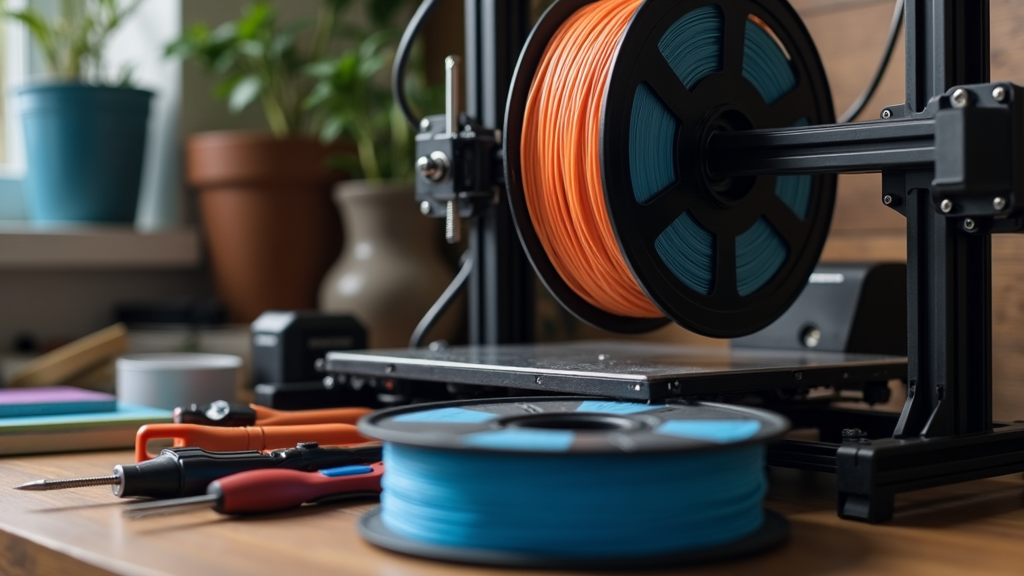
Confused about cheap vs. premium 3D printing filaments? Learn the real differences in quality, performance, and value so you can choose the best filament for your hobbyist projects.
The Filament Dilemma: Price Tag vs. Performance
For hobbyist 3D printers, choosing between budget and premium filament isn’t just about saving money—it’s about balancing creativity, reliability, and end-use expectations. While cheaper filaments can get you printing faster and more affordably, they often come with hidden trade-offs in terms of consistency, adhesion, and finish. On the flip side, premium filaments promise exceptional quality but demand a higher investment. The key to making the right choice lies in understanding when cost-cutting becomes a liability—and when it’s a smart strategy.
What Defines “Budget” vs. “Premium” Filaments?
At a glance, filament is filament—same spools, same shapes. But the distinction between budget and premium runs deeper than price. Budget filaments typically cost under $20 per kilogram and are mass-produced with fewer quality control checks. They may vary in diameter, color uniformity, or moisture content. Premium filaments, often priced between $30–$50 per kg or more, go through rigorous quality assurance processes and tend to be more refined in diameter tolerance, pigmentation, and packaging.
A hobbyist printing functional prototypes may not need a showroom finish every time. But if dimensional accuracy, surface quality, or long-term strength matters, knowing the distinction becomes vital. It’s not about brand snobbery—it’s about matching the filament to the task.
Print Quality: Where Filament Really Matters
The most immediate difference between budget and premium filaments is surface quality and layer adhesion. Inconsistent filament diameters—common in lower-end options—can cause under-extrusion, blobs, or weak layers. This makes printing detailed models or interlocking parts more frustrating. Premium filaments tend to produce cleaner, smoother surfaces with fewer failures, especially on longer prints.
If your hobby involves miniatures, mechanical components, or large-format art, these subtle differences can snowball into tangible improvements—or headaches. For functional hobbyists printing jigs, drone parts, or cosplay gear, a failed print due to brittle or moisture-laden filament can waste more time and money than the upfront savings justify.
Performance Under Pressure: Durability, Heat, and Impact
Budget filaments, especially PLA and ABS, can be surprisingly decent for general use—but they often lack the additives or manufacturing consistency that allow parts to endure stress, heat, or UV exposure. Premium brands might add impact modifiers, enhanced color pigments, or UV stabilizers to help models last longer in real-world applications.
Say you’re printing an RC car shell or a GoPro mount. A premium PETG with impact resistance and lower warping tendencies can outperform its cheaper cousin—not just in appearance, but in actual performance. For indoor models or temporary fixtures, the durability difference might not matter. But for outdoor use or mechanical stress, the choice is clear: pay now or reprint later.
Print Settings and Tuning: Time Is Money Too
Budget filaments can often require extra time to dial in your slicer settings. Minor inconsistencies mean more tweaking—recalibrating flow rates, adjusting temps, or even applying extra bed adhesive. For beginners, this can turn a fun hobby into a source of frustration.
Premium filaments are typically engineered for plug-and-play experiences, with tighter tolerance and reliable manufacturer profiles in slicers like PrusaSlicer, Cura, or Bambu Studio. For hobbyists who print frequently or on tight schedules, the reduced setup time and higher print success rate of premium filaments can save hours each week.
Specialty Filaments: When Premium Is the Only Option
Materials like carbon-fiber-infused nylon, glow-in-the-dark PLA, or high-temp PC often fall squarely into the premium camp. They require precision manufacturing and carefully sealed packaging to avoid degradation. If you’re exploring specialty applications—such as wearable prints, automotive parts, or translucent art—you’ll quickly find that bargain options simply don’t exist or aren’t worth the gamble.
For hobbyists looking to expand beyond standard PLA or ABS, investing in premium brands opens the door to a broader, more reliable material palette.
Hidden Costs of Cheap Filaments: Print Failures and Hardware Wear
Cheap filament might seem like a win for your wallet, but the real cost sometimes hits your printer. Abrasive pigments, inconsistent extrusion, and poor moisture resistance can clog nozzles, damage PTFE tubes, or even degrade hotend components over time. Hobbyists who’ve dealt with under-extrusion or “clicking” extruders know the pain of a single bad spool ruining an entire day—or worse, a multi-hour print.
On the flip side, premium filament manufacturers often vacuum-seal their rolls with desiccants, maintain tight QA tolerances, and test each batch. The result? Fewer jams, smoother extrusion, and longer hardware life. That’s a hidden savings worth factoring in.
When Budget Filaments Makes Sense
Not every print demands premium quality. If you’re prototyping parts, testing designs, or teaching kids how to 3D print, budget filament absolutely has its place. Brands like Inland, Sunlu, and AmazonBasics have built loyal followings by offering solid performance for general use. Many hobbyists use budget filament for first-pass prints or internal components that don’t need to look pretty or perform under stress.
The key is knowing when “good enough” is actually good enough—and when it’s setting you up for frustration.
Balancing Cost and Quality: A Smart Hobbyist’s Strategy
If you’re printing on a budget, you don’t have to go all-in on premium filament for every roll. Many experienced hobbyists adopt a tiered approach: use affordable filament for test prints, and premium filament for final models or functional parts. Others subscribe to loyalty programs or wait for holiday sales to stock up on high-end materials.
Being strategic with your filament purchases can stretch your budget without sacrificing performance when it counts. Over time, the knowledge you gain from experimenting with different brands and types will make you a more efficient, confident maker.
Final Verdict: Print Smarter, Not Just Cheaper
Choosing between budget and premium filament isn’t a binary decision—it’s a context-driven choice. If you’re making toys, one-off props, or casual prints, a low-cost filament might serve you just fine. But if quality, durability, and time-efficiency are priorities, investing in premium materials pays dividends in reliability and long-term value.
For hobbyist 3D printers, the smartest path forward isn’t picking one over the other—it’s knowing when to use each to your advantage.
FAQ
What’s the difference between budget and premium 3D printer filament?
Budget filaments are cheaper and may lack consistent quality, while premium filaments offer tighter tolerances, better finishes, and fewer print failures.
Is it worth paying more for premium filament?
If you prioritize surface quality, functional strength, and reliable printing, premium filament can save time and reduce frustration in the long run.
Can you use cheap filament for important parts?
It’s possible, but not recommended. Important parts benefit from the consistency and strength of higher-end materials.
Which budget filament brands are reliable?
Brands like Sunlu, eSUN, and Inland are known for offering decent quality at affordable prices, making them popular among hobbyists.
How do I know if a filament is causing print issues?
Signs include inconsistent extrusion, stringing, poor bed adhesion, or clogs, often due to moisture or poor diameter tolerance.

